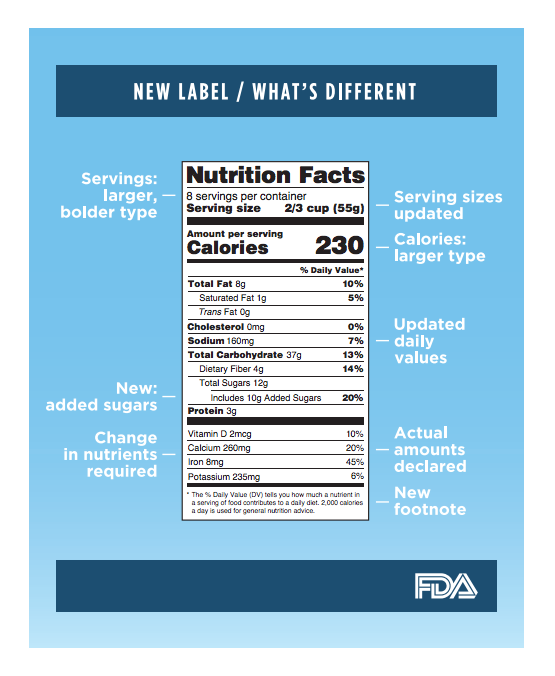By Kellie Casavale, PhD, RD, Nutrition Advisor, ODPHP
Last year the U.S. Food and Drug Administration (FDA) finalized a new Nutrition Facts label loaded with information designed to help people make healthier food and beverage choices. The label still includes key information for patients such as sodium, and saturated and trans fat, but also some new information including added sugars. As the updated Nutrition Facts labels begin appearing in the marketplace, your patients and clients could use your help in learning how to understand the new information on the label, along with the existing information, to improve their food and beverage choices. 
That’s why FDA released a new resource called Food Facts: New and Improved Nutrition Facts Label. We encourage you to share it with your patients and clients so they can use the label to:
- Understand serving sizes and servings per container
- Compare the calorie content of foods and beverages
- Understand percent Daily Value (%DV) and how to apply it to their food choices
- Learn and compare the nutrient content of foods
Before the release of the new Nutrition Facts label, the label had not been substantially updated in 20 years. The new label more accurately reflects current nutrition science and makes it easier to follow the recommendations in the 2015-2020 Dietary Guidelines for Americans.
Say you’re working with patients and clients to help them cut down on added sugars as part of a healthy eating pattern. Added sugars contribute calories without providing other nutrients. The Dietary Guidelines recommends limiting added sugars to less than 10% of total calories. For a 2,000 calorie diet that’s less than 200 calories or 50 grams of added sugars a day through foods and drinks.
The information on the Nutrition Facts label can help your patients and clients limit calories from added sugars. It includes added sugars in both grams and as a percent Daily Value (%DV). A healthy diet can accommodate some added sugars; understanding %DV can help your patients make sure they’re not getting too many — 100% DV for added sugars on the Nutrition Facts label is equal to 10% of total calories for a 2,000 calorie diet. Added sugars add up, but learning how to use the new Nutrition Facts label can help people identify and limit them — and ultimately make healthier choices in the long run.
Although the new Nutrition Facts label is already in use on some foods and beverages, it will take some time before it is on almost all labels. In the meantime, you can use this handout to teach your patients strategies like these for cutting down on added sugars:
- Encourage your patients to use USDA’s Supertracker to find out how many calories from added sugars they are currently consuming.
- Help your patients make some healthy shifts by replacing foods and drinks high in added sugars with healthier options. Some examples include eating fruit for dessert instead of cookies or cakes, swapping sugary cereals for unsweetened cereal with fruit, and drinking water or low-fat milk instead of sodas.
- Teach your patients how to check the ingredients list on food labels for added sugars. Added sugars hide in foods that you might not expect. They’re common in foods like pasta sauces, crackers, condiments, pizzas, and more.